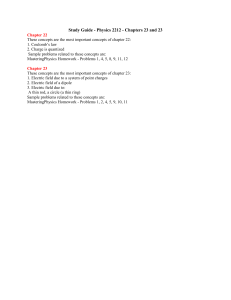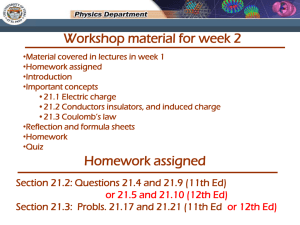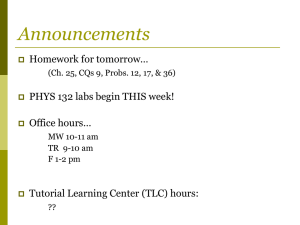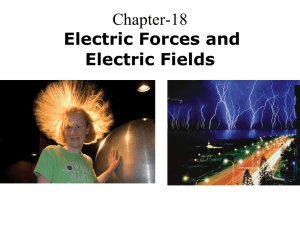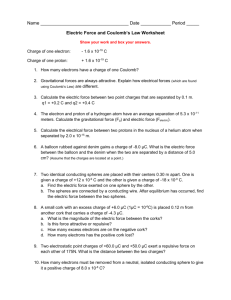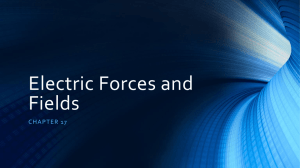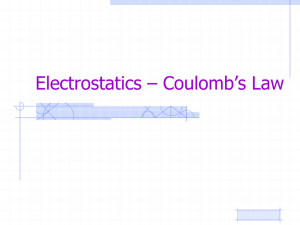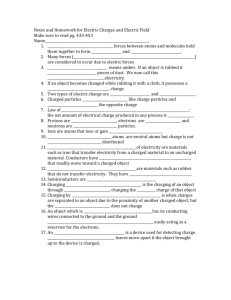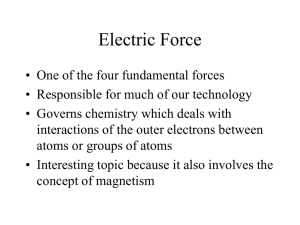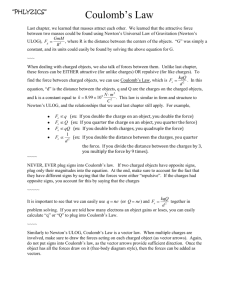Lecture 1 ppt version
advertisement
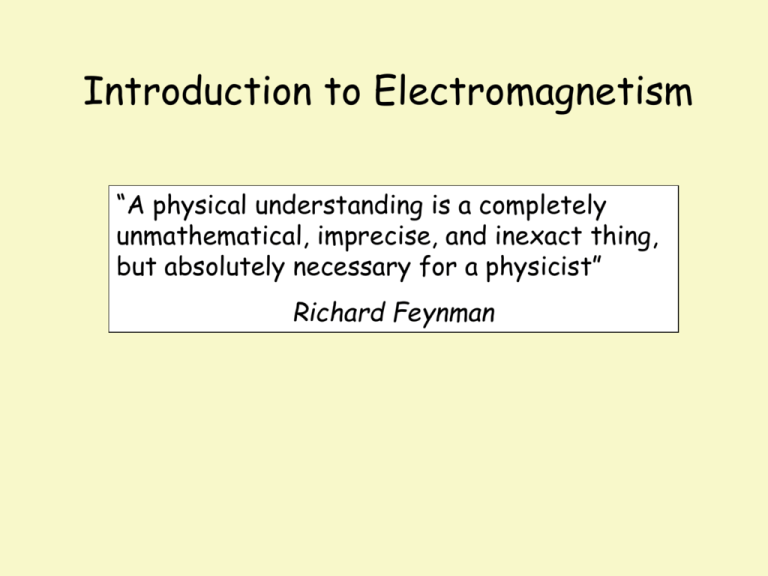
Introduction to Electromagnetism “A physical understanding is a completely unmathematical, imprecise, and inexact thing, but absolutely necessary for a physicist” Richard Feynman Why study electromagnetism? Maxwell’s Equations explain a diverse range of phenomena, from why a compass needle points north, to why a car starts when you turn the ignition key. They are the basis for the functioning of such electromagnetic devices as electric motors, cyclotrons, TV transmitters and receivers, telephones, fax machines, radar and microwave ovens. Our aim is to understand these equations, not necessarily remember them Online resources: (1) Weekly Reading Quiz Take online quiz anytime each week: Quiz 1 in Week 1 etc. Follow links from School page to first year units, course material http://www.phys.soton.ac.uk/teach/year1/notes/phys1022/ then click on reading quizzes Reading for Quiz 1: Wolfson 20.1 – 20.3 These are not counted in assessment for the course. They are meant to test your understanding, so that you can return to the text if you get them wrong. You can take them more than once in order to correct your errors. (2) Problem sets will be available online each week. The link to the problems is on the PHYS1022 front webpage. It is: http://www.masteringphysics.com/ The presentation about MasteringPhysics and how to register is also on the webpage. A further notice about registering for the e-Book is contained in an Announcement on MasteringPhysics (which went out as an email). These problems must be completed by the set deadline, which will be clearly stated (usually Friday at 12 midnight). (3) Problems sheets will also be distributed at the Wednesday Workshop. They will be available online as well. They contain conceptual problems to be discussed in your tutorials. The problems will be done in Wednesday Workshops, where help will be available. You may also get help with these from your tutor, who will have a copy of the answers. Answers to these problems will be posted on the MasteringPhysics page after a suitable interval. Hints on Lectures and note-taking Taking notes is an important skill. The act of writing in a lecture should help fix the material in your memory so that it is easier to recall later. What you record in a lecture gives you a reminder of what to go over later, and understand better. In lecture: • No need to write everything. Note main facts, ideas, results. • Listen to what is said. It is difficult to write and listen. • Underline or highlight important points. • Use simple diagrams. • Most importantly, if you don’t understand something, make a note of it. Hints on Lectures and note-taking After lecture: • Read through notes as soon as possible. • Copy them out again, especially if messy, adding to them from textbook. • Sort out the points you don’t understand, read up, ask me, or tutor. • Discuss with friends, as this really helps understanding. Summary sheets will be provided before the lectures each week, and lecture slides will appear on the web page for PHYS1022 after the lecture. In this lecture you’ll learn • How matter and many of its interactions are fundamentally electrical • About electric charge as a fundamental property of matter • To describe the electric force between charges and by the end of this week: • The concept of electric field – How to calculate the fields of discrete and continuous charge distributions • How charges respond to electric fields Same signs repel Opposite signs attract Coulomb’s Law quantifies the forces drawn Compare with gravity (see tutorial discussion question on Sheet 1) Electric Charge, Force and Field Wolfson chapter 20 Some spectacular holiday pictures… One of these is untrue – which is it? A. Insulators can be charged B. Charged objects attract neutral objects C. Neutral does not mean ‘no charges’ D. Charge is not an object – it is a property of matter E. There is no fundamental reason why electrons have to be negative F. There is no difference between charge and current Answer: F, current is motion of charge A and B: e.g. balloon sticking to wall. Charge conservation – charge is transferred, not created Charge quantisation C EXERCISE: A. -1 B. -2 C. -3 D. -4 Answer: -1 Answer: -1 Conductors and Insulators In materials such as wood or glass, all the electrons are bound to nearby atoms and none can move freely. These materials are called insulators. In many materials, such as copper and other metals, some of the electrons are free to move about the entire material. Such materials are called conductors. Charging by induction (a) Conductors in contact become oppositely charged when a charged rod attracts electrons to the left sphere (b) if the spheres are separated before the rod is removed, they will retain their equal and opposite charges (c) When the rod is removed and the spheres are far apart, the distribution of the charge on each sphere approaches uniformity EXERCISE: Two identical conducting spheres, one with an initial charge +Q, the other initially uncharged, are brought into contact. (a) What is the new charge on each sphere? A. +Q or +½Q. Since the spheres are identical, they B. +½Q must share the total charge equally. (b) While the spheres are in contact, a negatively charged rod is moved close to one sphere, causing it to have a charge of +2Q. What is the charge on the other sphere? A. –Q or –Q, necessary to satisfy the conservation B. –2Q of charge. C. other 20.2 Coulomb’s Law Charles Coulomb (1736-1806) studied the force exerted by one charge on another using a torsion balance of his own invention. EXERCISES using Coulomb’s law – the concept Equal and opposite forces The magnitude and direction of the electric force exerted by a charge q1 on another charge q2 a distance r away is given by where k is an experimentally determined constant k = 9.0 x 109 N.m2/C2 (we will abandon this later in the course) Diagram notation unit vector needed! source charge field charge field charge is now negative Example 20.1 p 331 Finding the electric force: two charges A 1.0 μC charge is at x = 1.0 cm, and a -1.5 μC charge is at x = 3.0 cm. What force does the positive charge exert on the negative one? Read Problem-Solving Strategy for using Coulomb’s Law on p 330 Interpret: identify the source charge Develop: draw coordinates and position of charges determine unit vectors (are any along the axes?) Evaluate: using Coulomb’s law remembering force is a vector Assess: is the force in the direction you expect for the sign of the charges? Do on board End of Lecture 1 To access e-Book • AFTER you have registered for MasteringPhysics • Go to www.coursecompass.com • Now you answer YES to ‘Do you have a Pearson’s account?’ • You will need the below access code: ISFSC-KNEAD-STAND-NEAGH-TAROT-TAXES • You will need the below course ID pearsoncustom22663
